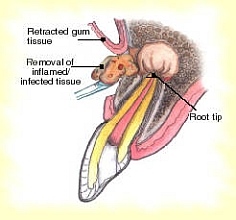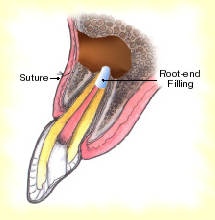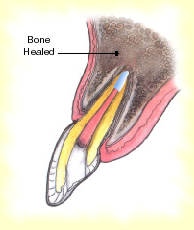

Although there are many surgical procedures that can be performed to save a tooth, the most common is called apicoectomy or root-end resection. When inflammation or infection persists in the bony area around the end of your tooth after a root canal procedure, your endodontist may have to perform an apicoectomy. This is usually followed with a root end filling to ensure that there is a complete seal of the old root canal filling at the end of the root.
Surgery may be used in diagnosis. If you have persistent symptoms but no problems appear on your x-rays, your tooth may have a tiny fracture or canal that could not be detected during nonsurgical treatment. In such cases, surgery allows your endodontist to examine the root of your tooth, find the problem and provide treatment.
Sometimes calcium deposits make a canal too narrow for the cleaning and shaping instruments used in nonsurgical root canal treatment to reach the end of the root. If your tooth has this calcification, your endodontist may perform endodontic surgery to clean and seal the remainder of the canal.
Usually, a tooth that has undergone a root canal can last the rest of your life and never need further endodontic treatment. However, in a few cases, a tooth may fail to heal. The tooth may become painful or diseased months or even years after successful treatment. If this is true for you, surgery may help save your tooth.
Surgery may also be performed to treat damaged root surfaces or surrounding bone.
At the initial visit the endodontist will examine the tooth, take x-rays and discuss your treatment options. If you and your endodontist choose apicoectomy, the apicoectomy will be scheduled at that time for a future date.
At the apicoectomy appointment, the endodontist will administer local anesthetic to numb the tooth. After the tooth is numb, the endodontist will open the gum tissue near the tooth to see the underlying bone and to remove any inflamed or infected tissue. The very end of the root is also removed.
A small filling may be placed to seal the end of the root canal and a few stitches or sutures are placed in the gum to help the tissue heal properly.
Patient will return to our office in 5 to 7 days to remove stitches.
Over a period of months, the bone heals in around the end of the root.
Periodic follow-up x-rays will be taken to montior healing.
An apicoectomy may be required when an infection develops in the bony area around the end of your tooth. During the treatment, the canals are cleaned, and inflamed or infected nerve tissue is removed.

The Endodontist will cut and lift the gum away from the tooth so the root is easily accessible. Then, the infected tissue as well as the end of the root will be removed.

A filling will be placed to help seal the end of the root canal. The use of local anesthetics will make the procedure very comfortable.

Over a period of months, the bone will heal around the end of the root. However, most patients will be able to return to normal activities after only the first day of surgery.